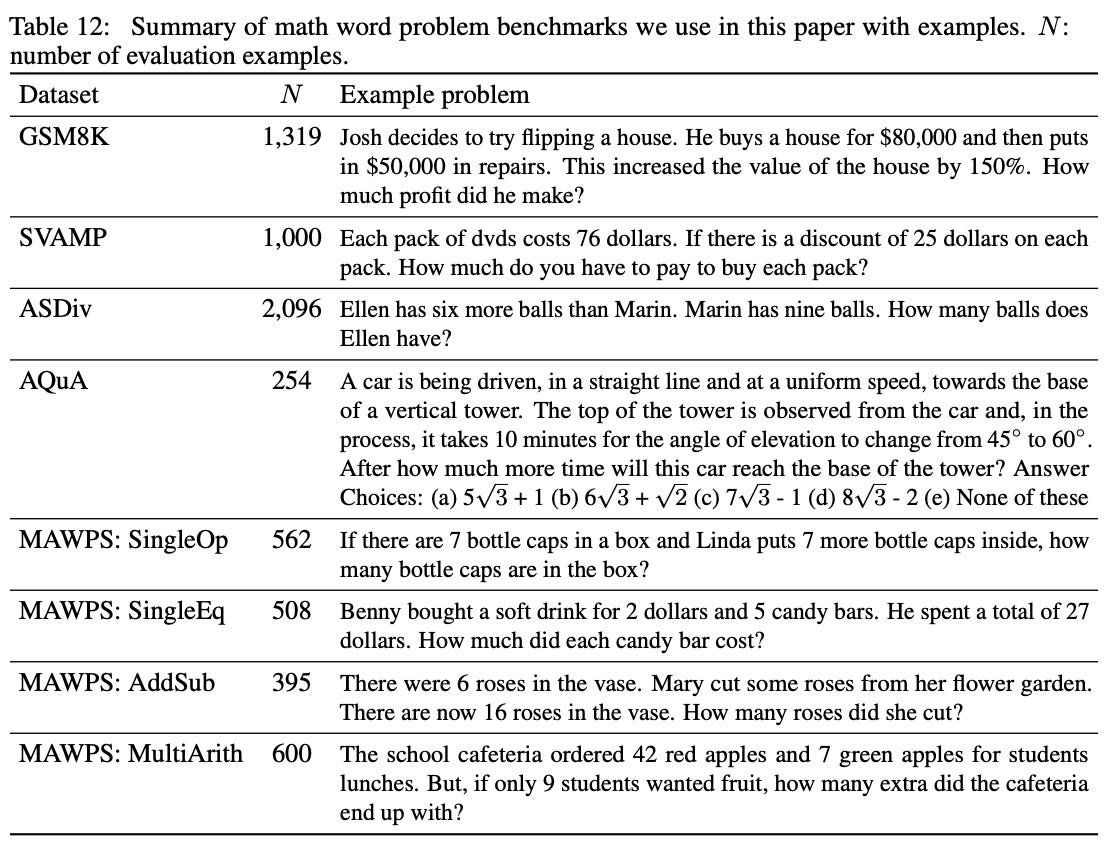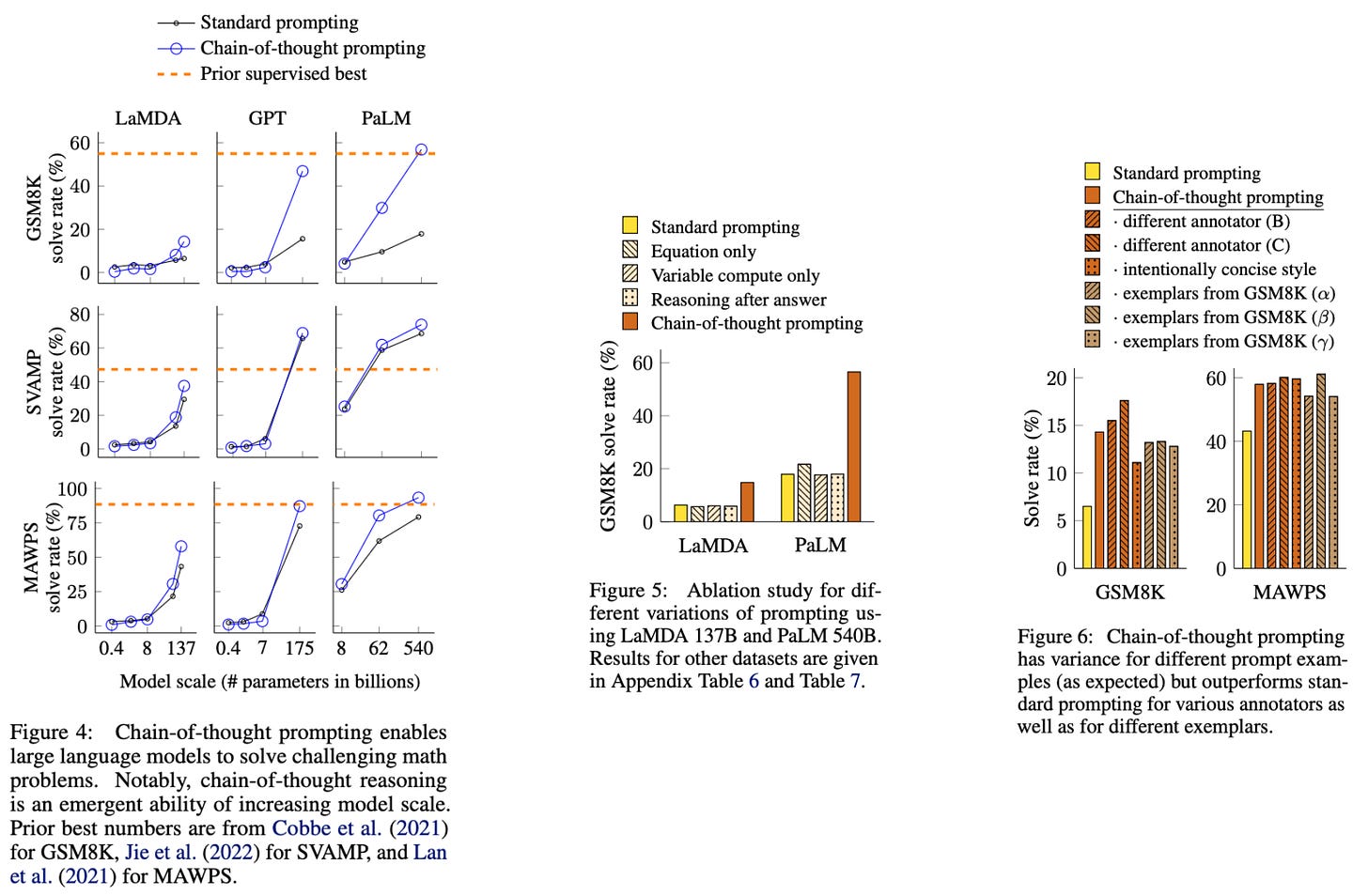Chain of Thought Prompting for LLMs §

Highlights §
- The success of large language models (LLMs) stems from our ability to pre-train (using a language modeling objective) decoder-only transformer models across massive textual corpora (View Highlight)
- Given that we pre-train sufficiently large models, LLMs are incredibly capable few-shot learners. (View Highlight)
- reasoning) are notoriously difficult. Initial attempts to solve this issue explored fine-tuning LLMs and task-specific verification modules over a supervised dataset of solutions and explanations of various reasoning problems (View Highlight)
- The goal of this paper is to endow language models with the ability to generate a chain of thought—a coherent series of intermediate reasoning steps that lead to the final answer for a problem.” - from [1] (View Highlight)
- chain-of-thought (CoT) prompting [1] is a recently-proposed technique that improves LLM performance on reasoning-based tasks via few-shot learning. Similar to standard prompting techniques, CoT prompting inserts several example solutions to reasoning problems into the LLM’s prompt. Then, each example is paired with a chain of thought, or a series of intermediate reasoning steps for solving the problem. The LLM then learns (in a few-shot manner) to generate similar chains of thought when solving reasoning problems. (View Highlight)
- LLMs within this section. Rather, we will focus upon developing a better understanding of prompting and few-shot learning for LLMs, as well as explore how such techniques may be leveraged to solve a core limitation of these models: their inability to solve reasoning tasks. (View Highlight)
- After the proposal of GPT-3 [2], we saw that LLMs of sufficient scale can perform few-shot learning quite well (View Highlight)
- These task-solving “prompts” enable zero-shot (i.e., without seeing examples of correct output; see above) or few-shot (View Highlight)
- But, sensitivity is a huge consideration in this developing field. LLM performance may change massively given small perturbations to the input prompt (e.g., permuting few-shot exemplars decreases GPT-3 accuracy from 93.4% to 54.3% on SST-2 [13]). Thus, in our study of prompting approaches, we aim to find techniques that i) perform well and ii) are not subject to sensitivity. (View Highlight)
- LLM few-shot learning performance improves with scale, but large models are not all that we need. Powerful LLMs require a combination of large models with massive pre-training datasets [14]. (View Highlight)
- we tend to see that using larger models and pre-training datasets does not improve LLM reasoning abilities (View Highlight)
- many researchers claim that LLMs are simply regurgitating training data rather than performing any complex reasoning or analysis. (View Highlight)
- With these limitations in mind, it becomes clear that using a prompting-only approach (e.g., CoT prompting) to solving reasoning tasks would be much simpler (View Highlight)
- Instead of fine-tuning an LLM to perform a task, we just “prompt” a generic model with a few examples of the correct output before generating a final answer. Such an approach is incredibly successful for a range of tasks. (View Highlight)
- prompting only approach is important because it does not require a large training dataset and a single model can perform many tasks without loss of generality.” - (View Highlight)
- Although this example is simple, the idea extends to a variety of mental reasoning tasks that we solve as humans. We generate a chain of thought (defined as “a coherent series of intermediate reasoning steps that lead to the final answer for a problem” (View Highlight)
- Authors in [1] find that such a prompting approach leads LLMs to generate similar chains of thought when solving problems, which aids reasoning capabilities and has several notable benefits: (View Highlight)
- • Interpretability: the LLM’s generated chain of thought can be used to better understand the model’s final answer.
• Applicability: CoT prompting can be used for any task that can be solved by humans via language.
• Prompting: no training or fine-tuning is required of any LLMs. We can just insert a few CoT examples into the prompt! (View Highlight)
 (View Highlight)
(View Highlight) (View Highlight)
(View Highlight)- From these experiments, we discover a few notable properties of CoT prompting. First, CoT prompting seems to work much better for larger LLMs (View Highlight)
- problems (e.g., GSM8K) see a greater benefit from CoT prompting. Compared to prior state-of-the-art methods (which perform task-specific fine-tuning), CoT prompting with GPT-3 and PaLM-540B achieves comparable or improved performance in all cases. (View Highlight)
- commonsense reasoning. Commonsense reasoning problems assume a grasp of general background knowledge and require reasoning over physical and human interactions (View Highlight)
- After the proposal of CoT prompting in [1], several variants were proposed that can improve the reasoning capabilities of LLMs (View Highlight)
- prompt engineering. As demonstrated by the examples above (and the idea of CoT prompting in general), curating a useful prompt for an LLM is an art (View Highlight)
- , we have seen that standard prompting is not enough to get the most out of LLMs. Rather, it seems to provide a sort of “lower bound” for LLM performance, especially on more difficult, reasoning-based tasks. CoT prompting goes beyond standard prompting techniques by leveraging few-shot learning capabilities of LLMs to elicit the generation of coherent, multi-step reasoning processes while solving reasoning-based problems. (View Highlight)

 (View Highlight)
(View Highlight) (View Highlight)
(View Highlight)